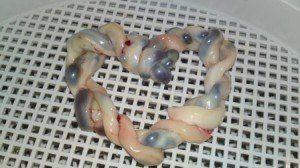For advice on Lotus birth and Placenta Encapsulation visit our Lotus birth page.
The benefits of delaying umbilical cord clamping and leaving the cord attached to your baby until it is completely drained of nutrient-rich blood are now becoming known again. It usually takes 5 – 60 minutes for the cord to stop pulsing; until then the cord should not be clamped or cut unless there is an emergency. Even during a caesarean section, most doctors will wait for 1 – 3 minutes if you ask – during this time just 180 seconds can change your baby’s life.
During the pulsating stage, the placenta is still providing your baby with up to 150mls of iron, oxygen and rich blood that is plentiful in important post-birth hormones, stem cells and T cells and other vitamins, minerals and nutrients. Placental hormones are known to help facilitate the mother/baby bonding process in the weeks after birth. Delaying in cord clamping has also been scientifically linked to higher iron levels in infants at 6 months of age.
Umbilical Cord Clamping Should Be Delayed, Says Expert, ScienceDaily (Aug. 17, 2007).
Dr David Hutchon, a retired Consultant Obstetrician from the Memorial Hospital in Darlington explains “Applying a clamp to the cord is clearly an intervention, having the greatest effect when it is done quickly after birth.” He fears that babies might be injured by very early clamping, for example, they could experience severe blood loss. Read the full article here.
Notice in the photos below that the cord on the left is white and pink with very little blood remaining in the cord – this cord has been emptied during the natural pulsing of the placenta after birth. The picture on the right shows a bulging cord filled with nutrient-rich blood. This cord was still pulsing when it was clamped and cut.


Milking the Cord
Some midwives now recommend giving a newborn baby their ‘cord blood’ (the blood left in the cord after the baby is born), also known as ‘milking the cord’. Milking the cord must take place after the birth of the placenta but before the cord has been cut. This process is very beneficial for babies who are struggling to breathe or are having difficulties in the minutes following birth. Giving baby cord blood involves squeezing the cord at the base of the placenta and pushing/squeezing along any remaining blood left in the cord into the newborn at the belly button base.
This TED video featuring Dr Alan Greene beautifully explains how important your baby’s cord blood is.
Information provided by IPEN Placenta Network, Professional Training in Placenta Services
